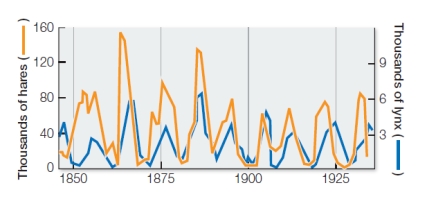Multiple Choice
Refer to the graph below, showing population cycles of snowshoe hares and their predator, Canada lynx.Population numbers were collected when both populations were trapped for the fur trade.  In the study of snowshoe hares and Canada lynx, this predator-prey interaction showed tightly controlled population cycles of approximately 10 years.The hares' numbers peaked, followed by peaks in lynx numbers approximately 2 to 3 years later.Assuming a cause-and-effect relationship between the two species, if lynx were removed from the community, the hare population would likely
In the study of snowshoe hares and Canada lynx, this predator-prey interaction showed tightly controlled population cycles of approximately 10 years.The hares' numbers peaked, followed by peaks in lynx numbers approximately 2 to 3 years later.Assuming a cause-and-effect relationship between the two species, if lynx were removed from the community, the hare population would likely
A) grow indefinitely without lynx to control its numbers.
B) grow exponentially at first but crash when it ran out of food.
C) grow exponentially at first but level off as hares adapted to the new condition.
D) continue to undergo cycles, with some other factor replacing lynx as a control.
E) show erratic population numbers, with no obvious cycles or other patterns.
Correct Answer:

Verified
Correct Answer:
Verified
Q74: When a parasite first invades a host,
Q75: Because they live outside their hosts, ticks
Q76: In the following situations, which organism would
Q77: When two populations of flour beetles, the
Q78: You find a series of related plants
Q80: Refer to the table below. <img src="https://d2lvgg3v3hfg70.cloudfront.net/TB5650/.jpg"
Q81: When sap-sucking leafhoppers feed on potato plants
Q82: A Geometridae caterpillar eating leaves avoids detection
Q83: An herbivore species would most likely exert
Q84: Rain forest trees provide habitats for many